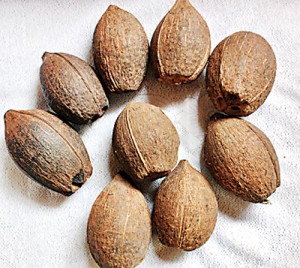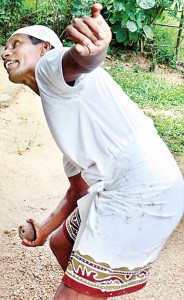Meeting nut with nut
View(s):An expert at Pora Pol, a traditional game, Weddikkarage Abeysinghe is determined to take part in the ritual come Avurudu as long as he can, he tells Dhananjani Silva
Clad completely in white – his sarong, banian and turban, all in pure white, Weddikkarage Abeysinghe is ready to perform a sacred act. In his hands he holds a rather unusual type of a coconut – smaller in size than the usual nut we know.

The rare cocnuts that are considered sacred
The firm grip he has on the coconut is symbolic of how this middle-aged gentleman from the outskirts of Pannipitiya, is holding fast to a traditional game – the Pora Pol (nut cracking) which once occupied a predominant place among Avurudu games as something with a religious element to it.
Abeysinghe anticipates the arrival of Sinhala and Tamil Aluth Avurudu with great pleasure as it gives him a chance to take part in this traditional Pora Pol game- a practice he has followed for the past 50 years since he was a lively lad of eight. Come April, this retiree puts aside all his other activities to practise Pora Pol to take part in Avurudu celebrations held close to his home.
A ritualistic activity to derive blessings from Goddess Pattini during the spread of illnesses in the village, the practice of playing Pora Pol, is believed to have originated from Matara some 300 or 400 years back, Abeysinghe believes.
“It was a prominent part in Gammadu ceremonies where two or three months prior to holding Pattini pooja at Gammadu ceremonies, villagers engage in breaking Pora Pol. Like that they go on to crack thousands of nuts for weeks. As a kid I too have done it while in Matara and this was the starting point,” he says.
Abeysinghe tells how people who engage in this ritualistic activity of cracking Pora Pol seeking divine blessings, become pure vegetarians months in advance. Playing Pora Pol takes place in the vicinity of a Devalaya and prior to commencing the game at an auspicious time, the Kapu mahattaya of the Devalaya engages in yathikawa (invocation)asking for divine blessings for the village as well for the safety of the players during the game. The reason why players are clad in full white is because it is an act of divinity, he says, adding that at the conclusion of the ceremony, the smashed coconuts are not consumed but used to produce oil for lighting the lamps.
 The Pora Pol breaking activity is still takes place in areas like Matara, Galle on a grand scale, and this ritual became a part of Avurudu celebrations as a folk game, he adds.
The Pora Pol breaking activity is still takes place in areas like Matara, Galle on a grand scale, and this ritual became a part of Avurudu celebrations as a folk game, he adds.
A game that demonstrates the courage, physical prowess and the tactical thinking of the male, it requires two teams, an equal number of players on both sides (even a single pair can take part in the game) with an equal number of nuts on either side. The two teams are referred to as ‘Udu Pila’ and ‘Yati Pila’. At the start of the game, the number of coconuts is counted and as the game progresses, members from each team come forward one by one to face an opponent. Taking turns, they throw the nuts with full force in the direction of the opponent while the latter targets the oncoming nut to smash it with the one he holds in his hand, Abeysinghe explains. At the end of the game, when the stack of coconuts of each team is counted, the side that has the highest number of nuts unbroken, wins the game.
A veteran in the art of Pora Pol breaking, Abeysinghe is familiar with every aspect of the game, including the different nuts and where to find the ones best suited for the game.
“You get the best Pora Pol from Matara while in areas like Galle, Kurunegala, and Polgasowita too you find these coconuts. Ones that are from Matara are very hardy and ideal for the game,” he explains as he shows us a few more types –Samanalaya, Tikka and Kokmaduwa -the latter is named after a location while the other two are named after the manner in which they twist and turn when thrown.
“This is a risky game. The players use their full force when they throw the coconut at the rival team, not with the intention to hitting them but to avoid the opponent cracking it. There were instances that I suffered hand injuries,” he explains.
A few months prior to Avurudu, Abeysinghe makes a trip to Matara with his brother to collect a few of these special coconuts for the Pora Pol game.
“These coconuts are worth a lot because they are rare. People do not sell them, because they consider them sacred. Instead, they offer them to the devala and temples to be used for these ritualistic festivals. I also know a few owners who have this type of coconut trees planted in their estates. That is how I collect a few from here and there,” Abeysinghe reveals.
The game however, is fast disappearing, mainly due to the lack of skilled players and youngsters disinterested in learning the game or the difficulty in finding that special variety of nuts used for this purpose, explains Abeysinghe rather despondently. This, however, is the very reason he never misses taking part in a Pora Pol game every Avurudu.
An emotional Abeysinghe speaks of a few skilled people who mastered the art of Pora Pol playing. Among them is ‘Ebaran’ from Kahathuduwa – a genius at the game. “I was very small when I used to watch him play. Ebaran maama was at his peak at the age of about 50. Later on, in my 20’s I even played a game or two with him,” he recalls.
The tradition of Pora Pol breaking should be sustained he feels, stressing that he will continue to take part in this folk game for Avurudu as long as he can. He has two daughters and so Abeysinghe is now thinking of training his nephew to make sure the tradition continues.


